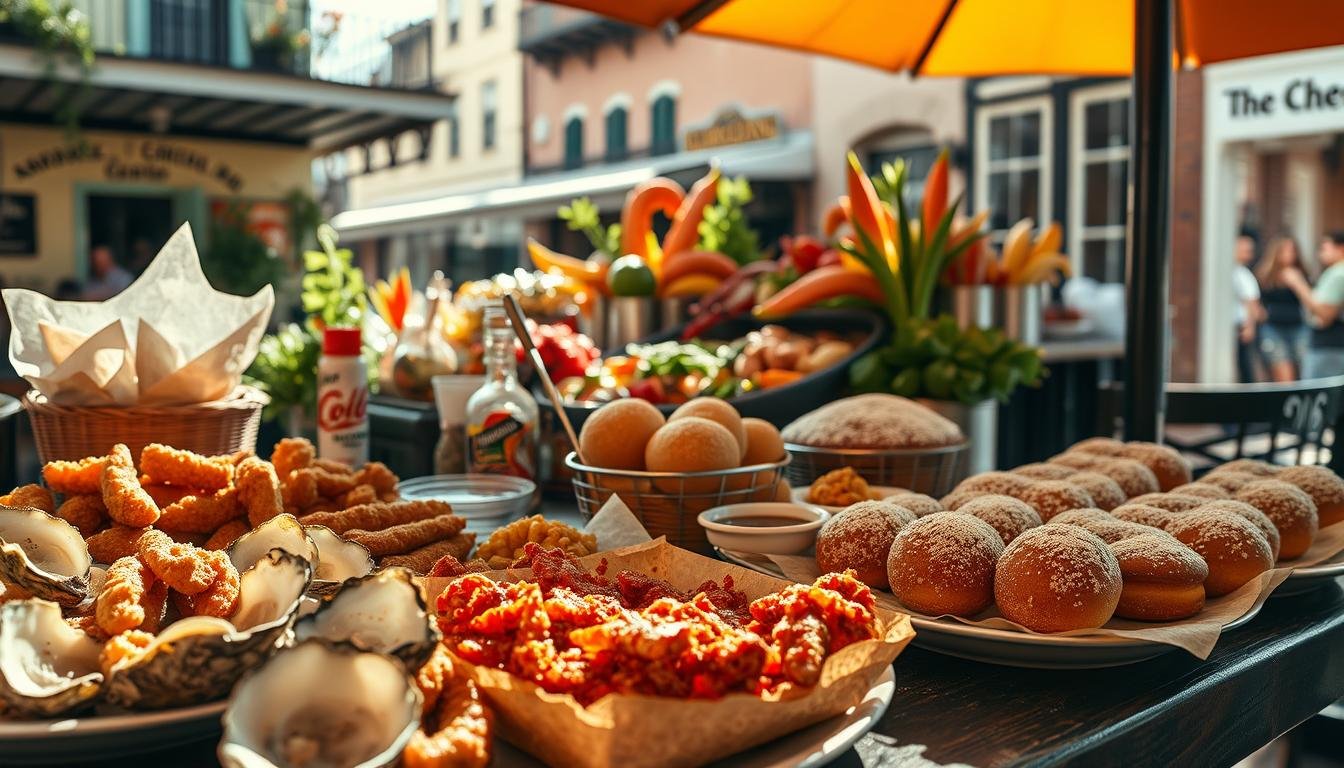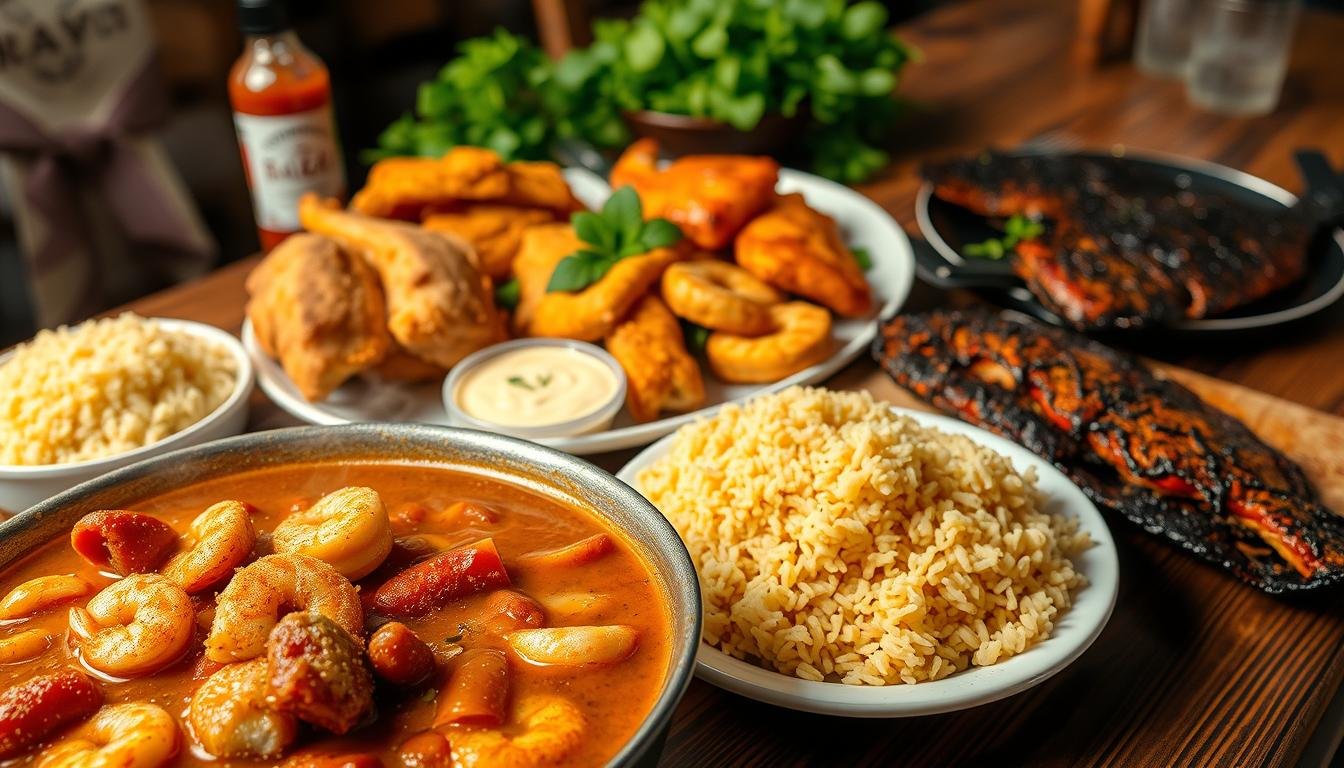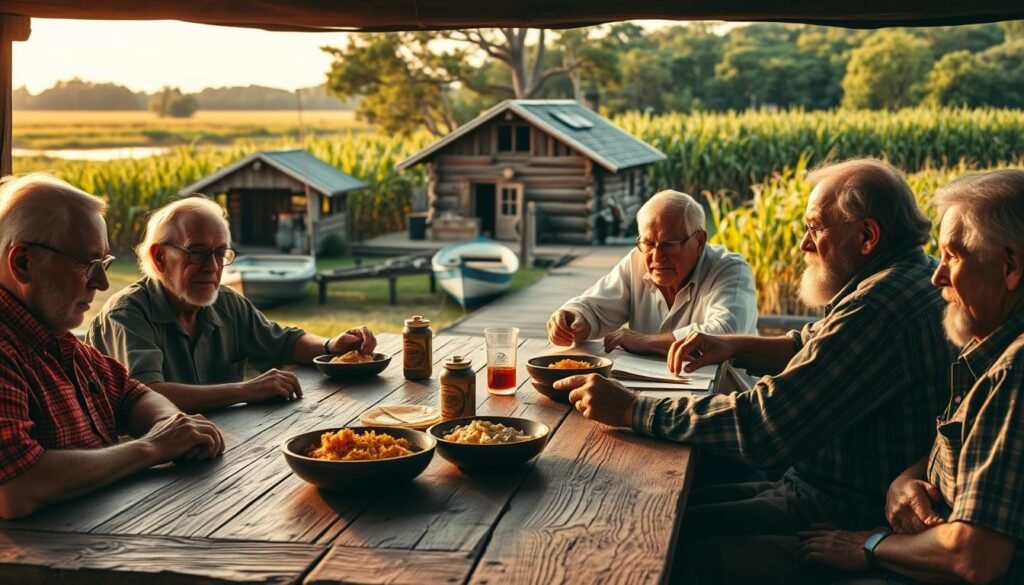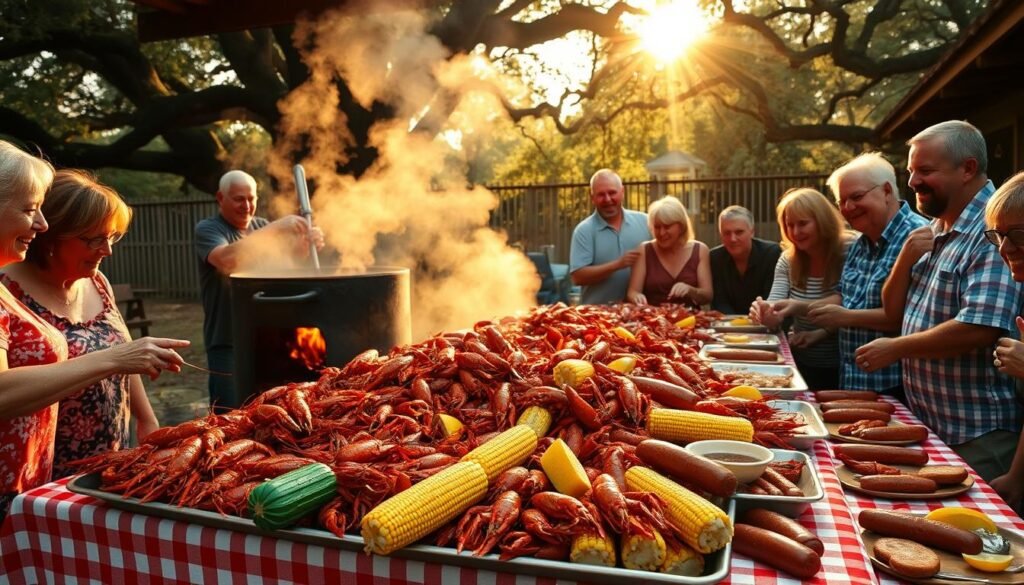As a local, I’m excited to share with you the vibrant culinary scene of the city that’s a melting pot of flavors and cuisines. From the rich history of our cuisine to the must-try dishes, we’ll take you on a journey through the best of the city.
The city’s unique blend of French, African, and Spanish influences makes it a foodie’s paradise. You’ll discover the top foodie spots, the local flavors that make our cuisine so authentic, and the best ways to experience the city’s culinary delights.
Key Takeaways
- Experience the city’s rich culinary history
- Discover top foodie spots and local flavors
- Learn about the unique blend of French, African, and Spanish influences
- Find the best ways to enjoy the city’s culinary delights
- Explore the city’s vibrant culinary scene
The Rich History of New Orleans Cuisine
The history of New Orleans cuisine is a story of cultural fusion, where different traditions came together to create something entirely new. This melting pot of flavors has been shaped by the city’s unique position as a port city, welcoming people and culinary practices from around the world.
Influences from French, African, and Spanish Cultures
New Orleans cuisine is characterized by its French, African, and Spanish roots. The French brought their sophisticated culinary techniques, while Africans contributed their knowledge of okra and other ingredients that became staples in gumbo. The Spanish added their own flair, particularly in the use of seafood and spices. This blend of cultures is evident in dishes like jambalaya, a one-pot meal that combines sausage, rice, and a variety of spices.
As noted by food historians, “the cuisine of New Orleans is a true reflection of the city’s cultural heritage, with each ingredient and cooking technique telling a story of its own.” This cultural exchange not only influenced the local cuisine but also helped shape the identity of New Orleans as a city.
The Birth of Creole and Cajun Cooking
The unique cultural landscape of New Orleans gave rise to two distinct culinary traditions: Creole and Cajun cooking. Creole cuisine, often associated with the city’s aristocracy, is characterized by its use of tomatoes, butter, and a variety of spices. In contrast, Cajun cuisine, originating from the Acadian people, is heartier and often features dark roux, a mixture of flour and fat used to thicken soups and stews.
- Creole cuisine is known for its sophistication and use of a wide range of ingredients.
- Cajun cuisine is celebrated for its rustic, comforting dishes.
Iconic Dishes with Historical Significance
Dishes like gumbo, jambalaya, and beignets are not just delicious; they also carry historical significance. For instance, gumbo is a testament to the African influence on New Orleans cuisine, with okra being a key ingredient. To explore more traditional New Orleans foods, visit https://www.neworleans.com/restaurants/traditional-new-orleans-foods/.
These iconic dishes have become synonymous with New Orleans, attracting visitors from around the world who come to experience the city’s authentic Creole cuisine and New Orleans culinary delights. Whether it’s the rich flavors of gumbo or the sweet, fried dough of beignets, each dish tells a story of the city’s rich cultural heritage.
Must-Try Dishes in New Orleans
New Orleans is a melting pot of flavors, and there’s no better way to experience this than by diving into its must-try dishes. The city’s culinary delights are a reflection of its rich cultural heritage, influenced by French, African, and Spanish cuisines.
Here are some of the top dishes you shouldn’t miss when visiting New Orleans:
- Gumbo: A hearty stew that warms the soul
- Jambalaya: A one-pot meal packed with flavor
- Beignets: Sweet treats that are perfect with café au lait
Gumbo: A Stew with Soul
Gumbo is more than just a dish; it’s a symbol of New Orleans’ cultural melting pot. This hearty stew combines ingredients like okra, rice, and a variety of meats and seafood, creating a rich and flavorful experience. The secret to a great gumbo lies in its roux, which is typically made with a combination of flour and fat. Variations abound, with some recipes using chicken, others sausage, and some a combination of both.
Jambalaya: A Flavorful One-Pot Meal
Jambalaya is another iconic New Orleans dish that showcases the city’s culinary prowess. This one-pot meal is a mix of sausage, rice, and a variety of meats, all cooked together to create a flavorful and filling dish. The beauty of jambalaya lies in its versatility – it’s a dish that can be made with a range of ingredients, from chicken and sausage to seafood and vegetables.
Beignets: A Sweet Treat from Café du Monde
No visit to New Orleans is complete without trying beignets at Café du Monde. These sweet fried dough pastries are covered in powdered sugar and are best enjoyed with a cup of café au lait. The experience is as much about the atmosphere as it is about the taste, with Café du Monde being a historic and iconic spot in the French Quarter.
Whether you’re a foodie or just looking to try something new, these must-try dishes in New Orleans are sure to satisfy your culinary cravings and leave you wanting more of the city’s local flavors.
Iconic Restaurants You Can’t Miss
New Orleans is renowned for its vibrant culinary scene, with iconic restaurants that have become synonymous with the city’s rich cultural heritage. These culinary landmarks offer a range of dining experiences that cater to all tastes and preferences, from fine dining to casual eats.
The city’s iconic restaurants are not just places to eat; they are institutions that have been woven into the fabric of New Orleans’ culture. As one of the top foodie spots in NOLA, these restaurants have garnered attention from food enthusiasts around the world.
Commander’s Palace: Fine Dining Experience
Commander’s Palace is a name that resonates with luxury and fine dining in New Orleans. Established in 1893, it is one of the city’s oldest and most prestigious restaurants. The Victorian-style mansion turned restaurant offers an exquisite dining experience with its Creole cuisine, impeccable service, and elegant ambiance.
“Commander’s Palace is a culinary icon, offering a dining experience that is as much about the food as it is about the history and ambiance of the restaurant.” –
With its award-winning wine cellar and innovative Creole cuisine, Commander’s Palace is a must-visit for anyone looking to indulge in the finer aspects of New Orleans dining.
![]()
Café du Monde: The Famous Beignet Spot
No visit to New Orleans is complete without a stop at Café du Monde, the world-famous café that has been serving beignets since 1862. This iconic café is a symbol of New Orleans’ culinary identity, offering a unique experience that combines delicious food with a historic atmosphere.
The café’s signature beignets, covered in powdered sugar, are a classic New Orleans treat that has been enjoyed by locals and visitors alike for generations. As one of the best restaurants in New Orleans for casual dining, Café du Monde is a must-visit destination.
Cochon: Culinary Showcase of Cajun Flavors
Cochon is another iconic restaurant in New Orleans that showcases the city’s rich culinary heritage, particularly its Cajun influences. The restaurant’s menu features a range of dishes that highlight the best of Cajun cuisine, from meats to vegetables, all prepared with a focus on local ingredients and traditional techniques.
With its commitment to using locally sourced ingredients and its dedication to preserving Cajun culinary traditions, Cochon offers a dining experience that is both authentic and innovative.
In conclusion, New Orleans’ iconic restaurants are a testament to the city’s vibrant culinary scene. Whether you’re in the mood for fine dining or casual eats, these restaurants offer a culinary journey that is quintessentially New Orleans.
Exploring Local Markets and Food Festivals
From the French Market to the New Orleans Jazz & Heritage Festival, the city’s food culture is on full display in its markets and festivals. New Orleans is a city that thrives on the culinary experiences it offers, and these events are a testament to its rich gastronomic heritage.
Culinary Delights at the French Market
The French Market is a historic outdoor marketplace that has been in operation since the 18th century. It’s a place where you can find a variety of local flavors, from Creole spices to handmade crafts. As you stroll through the market, you’ll discover artisanal food vendors offering samples of their latest creations, such as fresh beignets and gourmet pralines.
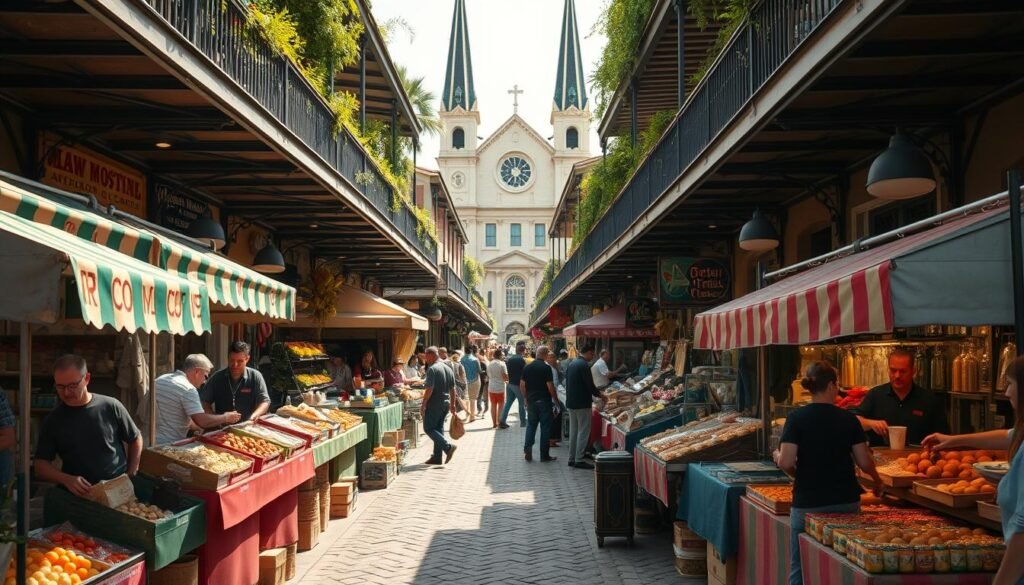
A Foodie’s Dream: New Orleans Jazz & Heritage Festival
The New Orleans Jazz & Heritage Festival, or Jazz Fest, is a celebration of the city’s music, culture, and cuisine. This event is a must-visit for any food enthusiast, with local chefs showcasing their culinary skills through cooking demonstrations and tastings. You’ll have the opportunity to sample a wide range of dishes, from gumbo to jambalaya, and experience the rich flavors of New Orleans.
The Freshest Ingredients: Farm-to-Table Movement
The farm-to-table movement has taken root in New Orleans, with many local restaurants and chefs emphasizing the use of fresh, locally sourced ingredients. This approach not only ensures the quality and authenticity of the dishes but also supports local farmers and producers. By visiting local markets and participating in food festivals, you can experience the best of New Orleans’ farm-to-table cuisine and appreciate the city’s commitment to culinary innovation.
Whether you’re a local or just visiting, New Orleans’ markets and food festivals offer a unique and delicious way to experience the city’s culture. So, take a stroll through the French Market, enjoy the culinary delights at Jazz Fest, and savor the flavors of the city’s farm-to-table movement.
Street Food and Food Trucks
New Orleans is renowned for its vibrant street food scene, a culinary melting pot that reflects the city’s rich cultural heritage. The city’s food trucks and street vendors offer a diverse range of must-try dishes in New Orleans, from classic comfort food to innovative Creole cuisine.
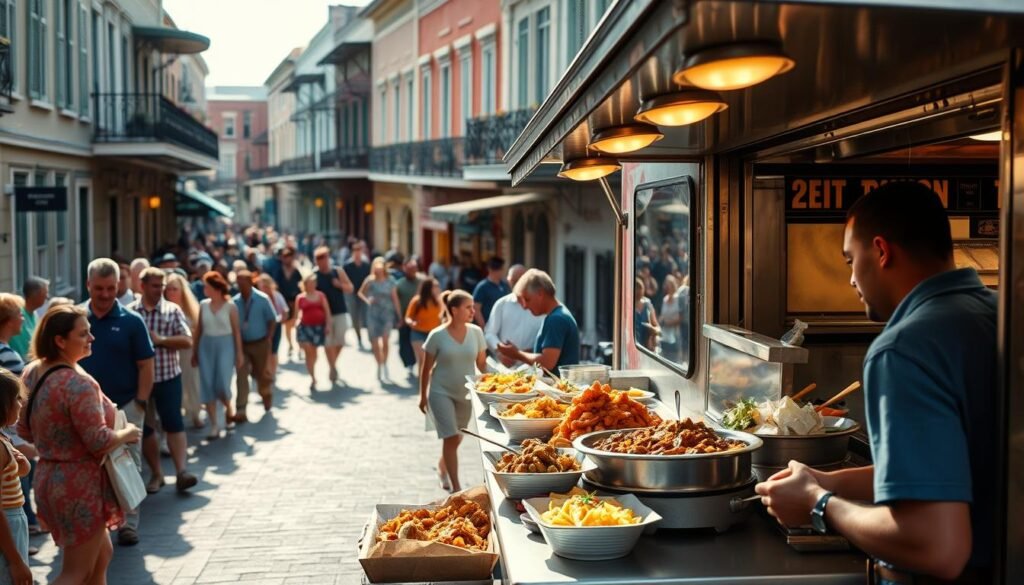
Po’ Boys: A New Orleans Classic
No visit to New Orleans is complete without trying a po’ boy, the city’s iconic sandwich. Typically served on crispy French bread, po’ boys are filled with a variety of ingredients, including fried oysters, shrimp, or roast beef, all piled high with local flavors of New Orleans. Whether you’re in the mood for something classic or adventurous, po’ boys are a staple of the New Orleans street food scene.
The Rise of Food Trucks: A Diverse Offering
Food trucks have become increasingly popular in New Orleans, offering a wide range of cuisines that cater to diverse tastes. From traditional Creole dishes to modern fusion cuisine, these mobile eateries bring authentic Creole cuisine to the streets, making it easier than ever to enjoy a delicious meal on the go.
| Popular Street Foods | Description | Price Range |
|---|---|---|
| Po’ Boys | Crispy French bread filled with fried seafood or roast beef | $10-$15 |
| Gumbo | Rich stew made with a combination of ingredients, including seafood and sausage | $8-$12 |
| Beignets | Fried dough pastries covered in powdered sugar | $5-$7 |
Creole Cuisine on the Go
The best part about street food and food trucks in New Orleans is the ability to experience the city’s rich Creole heritage in a casual, accessible way. Whether you’re grabbing a quick bite or enjoying a leisurely meal, the local flavors of New Orleans shine through in every dish, making street food a must-try during your visit.
The Art of Cooking Classes
Discover the secrets of New Orleans cuisine through our cooking classes, where the art of Creole and Cajun cooking comes alive. In these classes, you’ll learn the techniques and ingredients that make our dishes so unique.
Cooking classes in New Orleans offer an immersive experience, allowing you to dive into the heart of our culinary traditions. Whether you’re a seasoned chef or a curious foodie, you’ll find classes tailored to your interests and skill level.
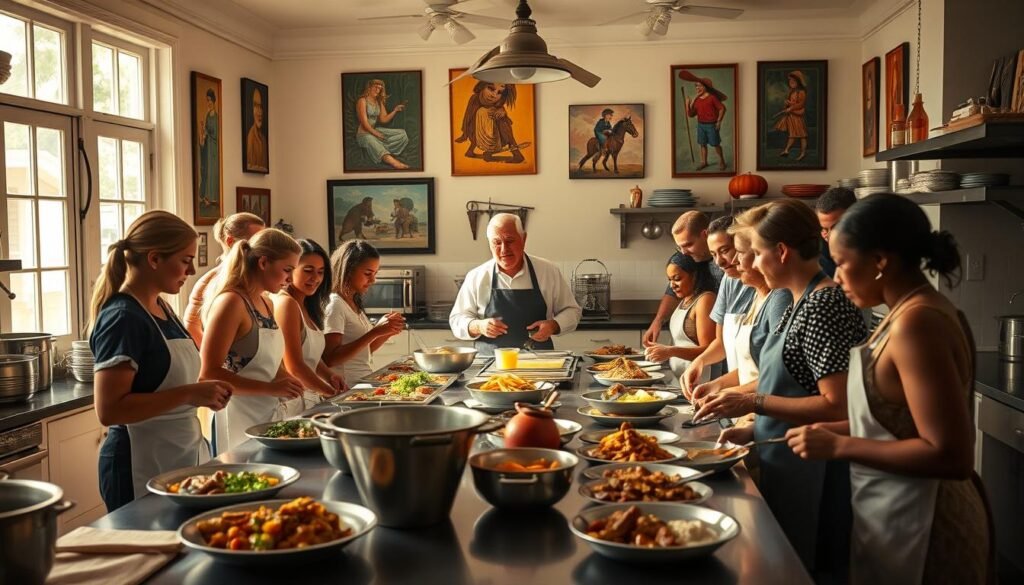
Learn to Cook Gumbo and Jambalaya
Two of the most iconic dishes in New Orleans cuisine are gumbo and jambalaya. In our cooking classes, you’ll learn the traditional methods for preparing these flavorful dishes, from selecting the right ingredients to mastering the cooking techniques that give them their distinctive taste.
Gumbo, a stew that combines elements of French, African, and Native American cuisine, is a true reflection of New Orleans’ cultural melting pot. Jambalaya, on the other hand, is a one-pot dish that’s as versatile as it is delicious, with variations that range from sausage and chicken to seafood.
Hands-On Experience with Local Chefs
One of the highlights of taking a cooking class in New Orleans is the opportunity to work alongside local chefs who are passionate about sharing their knowledge and expertise. These hands-on classes provide a unique chance to learn from the experts and gain insights into the techniques and traditions that shape our cuisine.
Under the guidance of experienced chefs, you’ll participate in preparing a variety of dishes, from appetizers to desserts, and enjoy the fruits of your labor in a convivial atmosphere.
Perfecting the Techniques of Cajun and Creole Cooking
Cajun and Creole cooking are at the heart of New Orleans cuisine, with techniques that have been refined over generations. Our cooking classes focus on teaching you these techniques, from the roux-making that underpins many of our sauces to the spice blends that add depth and complexity to our dishes.
By mastering these techniques, you’ll be able to recreate the flavors of New Orleans in your own kitchen, bringing a taste of the city’s culinary magic to your family and friends.
In conclusion, New Orleans cooking classes offer a unique culinary experience that combines hands-on learning with the rich cultural heritage of the city. Whether you’re looking to expand your cooking repertoire or simply want to immerse yourself in the local culture, these classes are an unforgettable way to experience the best of New Orleans.
Iconic Beverages to Pair with Your Meals
From the Sazerac to craft beers, New Orleans’ beverage scene is as diverse and flavorful as its cuisine. The city’s rich history and cultural influences have shaped its drinking culture, offering a wide range of iconic beverages that perfectly complement its culinary delights.
Sazerac: A Distinctive Cocktail
The Sazerac is more than just a cocktail; it’s a symbol of New Orleans’ resilience and creativity. Made with rye whiskey, absinthe, and Peychaud’s Bitters, this drink is a masterclass in balance and flavor. When sipped alongside iconic New Orleans dishes like gumbo or jambalaya, the Sazerac enhances the dining experience with its complex, spicy notes.
To enjoy an authentic Sazerac, head to the Sazerac Bar at the Roosevelt New Orleans, a historic venue that’s been serving this classic cocktail since 1850. The bar’s commitment to preserving the original recipe and method ensures that every Sazerac served is a true representation of New Orleans’ cocktail heritage.
Ramos Gin Fizz: A Foamy Delight
Another New Orleans classic is the Ramos Gin Fizz, a refreshing cocktail that’s as much a sensory experience as it is a drink. With its silky texture and the perfect balance of sweet and sour, this cocktail is a must-try when visiting the city. The best restaurants in New Orleans often feature the Ramos Gin Fizz on their menus, pairing it with dishes that highlight the city’s local flavors.
At Pat O’Brien’s, a legendary bar in the French Quarter, you can experience the Ramos Gin Fizz as it’s meant to be enjoyed. The bar’s skilled bartenders shake the cocktail to perfection, creating a frothy head that complements the drink’s citrus and gin flavors.
The World of Craft Beers in New Orleans
New Orleans is also home to a thriving craft beer scene, with breweries like Port Orleans Brewing Company and NOLA Brewing Company offering a range of beers that showcase the city’s innovative spirit. From IPAs to stouts, the craft beers of New Orleans are perfect for pairing with the city’s diverse culinary offerings, including its iconic New Orleans dishes.
Whether you’re enjoying a cold beer at a rooftop bar or sampling local brews at a beer garden, the craft beer scene in New Orleans is an integral part of the city’s dining culture. It offers a modern complement to the traditional cocktails and cuisine that the city is known for.
Unique Culinary Experiences
Beyond its iconic dishes, New Orleans offers a range of unique culinary experiences that showcase the city’s rich heritage. From exploring the depths of the swamp to cooking with local chefs, there’s something for every food enthusiast.
Swamp Tours and Dining Adventures
Imagine dining in the midst of a cypress swamp, surrounded by the sights and sounds of nature. Swamp tours with dining adventures offer a truly immersive experience, combining the thrill of exploring Louisiana’s wetlands with the delight of savoring local cuisine. You’ll have the chance to try alligator meat and other regional specialties in a unique setting.
“The experience was unforgettable,” says a local food blogger. “Dining under the stars in a swamp, with the sound of alligators in the background, was a thrill unlike any other.”
Cooking with Locals: Immersion in Culture
Cooking with locals is another way to experience the authentic flavors of New Orleans. By participating in a cooking class, you’ll learn the techniques behind authentic Creole cuisine and gain insight into the cultural heritage that shapes the city’s culinary identity.
- Learn to prepare traditional dishes like gumbo and jambalaya.
- Discover the secrets of Creole seasoning and spice blends.
- Enjoy the fruits of your labor with a meal shared with your new friends.
Culinary Tours: A Delicious Way to Explore
For those who want to explore the city’s culinary scene comprehensively, New Orleans food tours are the way to go. These tours take you to the top foodie spots in NOLA, introducing you to a variety of flavors and culinary delights. From beignet-filled breakfasts to cocktail-infused evenings, there’s a tour to suit every taste.
“New Orleans is a city that is as much about the food as it is about the culture and history. Taking a culinary tour is a great way to experience all that the city has to offer.”
Whether you’re a food enthusiast or just looking to try something new, New Orleans offers a culinary journey that’s as unique as it is delicious. With its rich history, cultural immersion, and of course, incredible food, the city is sure to leave a lasting impression on your palate and your memory.
Conclusion: Savoring New Orleans Culinary Delights
As we wrap up our culinary journey through New Orleans, it’s clear that the city’s cuisine leaves a lasting impression on all who experience it. The rich history, cultural influences, and iconic dishes all come together to create a truly unique dining experience.
The local flavors of New Orleans are a perfect blend of French, African, and Spanish cuisines, giving birth to the distinctive Creole and Cajun cooking styles. From must-try dishes in New Orleans like gumbo and jambalaya to beignets at Café du Monde, every bite is a testament to the city’s culinary heritage.
A City that Beckons Foodies
Whether you’re a seasoned foodie or just looking to try something new, New Orleans has something to offer. Take a stroll through the French Market, sample the city’s famous street food, or join a cooking class to learn the secrets of New Orleans culinary delights. The city’s vibrant culinary scene is waiting to be explored.
So come and experience the flavors of New Orleans for yourself. Let the city’s rhythm and cuisine captivate you – we can’t wait to welcome you to the culinary heart of the city.
FAQ
What’s the best way to experience the authentic flavors of New Orleans?
To truly experience the authentic flavors of New Orleans, try taking a food tour, visiting local markets like the French Market, or attending the New Orleans Jazz & Heritage Festival. You can also explore the city’s iconic restaurants, like Commander’s Palace or Café du Monde, and try cooking classes to learn the techniques behind Creole and Cajun cuisine.
What are some must-try dishes when visiting New Orleans?
Some must-try dishes in New Orleans include gumbo, jambalaya, beignets, po’ boys, and crawfish etouffee. Be sure to try these dishes at iconic restaurants like Dooky Chase’s Restaurant, Coop’s Place, or Café Maspero.
What’s the difference between Creole and Cajun cuisine?
Creole cuisine refers to the sophisticated cooking style that originated in New Orleans, characterized by the use of a variety of ingredients, including tomatoes, and a blend of French, Spanish, and African influences. Cajun cuisine, on the other hand, is a heartier, more rustic style that originated in rural Louisiana, characterized by the use of dark roux, seafood, and game meats.
Can I find vegetarian or vegan options in New Orleans?
Yes, New Orleans has a growing number of vegetarian and vegan options. Many restaurants now offer plant-based versions of traditional Creole and Cajun dishes, and some, like the vegan restaurant, Green Goddess, offer entirely plant-based menus.
How can I experience the best of New Orleans’ street food?
To experience the best of New Orleans’ street food, try visiting the city’s famous food trucks, like the famous Deanie’s Seafood, or checking out the street vendors at events like the French Quarter Festival. You can also try po’ boys at Parkway Bakery and Tavern, or sample the city’s best beignets at Café du Monde.
Are there any unique culinary experiences I can have in New Orleans?
Yes, New Orleans offers a range of unique culinary experiences, including swamp tours with dining adventures, cooking classes with local chefs, and culinary tours that take you through the city’s best food spots. You can also visit local markets, like the Crescent City Farmers Market, to sample the city’s freshest ingredients.
What’s the best way to pair my meal with a drink in New Orleans?
New Orleans is famous for its cocktails, like the Sazerac and Ramos Gin Fizz, which pair perfectly with the city’s Creole and Cajun cuisine. You can also try the city’s craft beers, like those from the NOLA Brewing Company, or sample some of the city’s best wines at a wine bar like the Wine Press.
